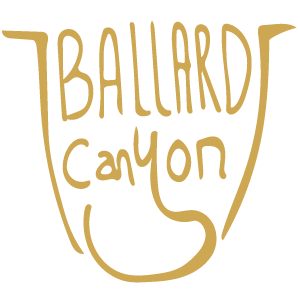Going sideways for Santa Barbara wines
Santa Barbara wine country is quite literally “Sideways.” What this top wine movie’s title hints at is the unique geography of Santa Barbara wine country. It is the longest transverse valley (East to West) found on the western Pacific coast–from Alaska to South America. This creates climate conditions perfect for world-class cool climate wines (like Pinot Noir and Chardonnay). Let’s find out what makes this region awesome and what wines to explore from Santa Barbara wine country.
“one of the coolest grape growing regions in California”
An Introduction to Santa Barbara Wine Country
Santa Barbara wine country offers a little bit of everything to the thirsty wine drinker. Wines are both elegant and sophisticated while maintaining down-to-earth minerality. They show an artful balance between fruit purity (think perfectly ripe berries), a rich velvety texture and freshness. The most commonly planted cultivars in the valley include:
- Chardonnay 7529 acres / 3047 ha
- Pinot Noir 5561 acres / 2250 ha
- Syrah 1928 acres / 780 ha
- Sauvignon Blanc 799 acres / 323 ha
You can note that certain parts of the region farther inland are warm enough to fully ripen Cabernet Sauvignon (and other Bordeaux varieties) as well as white and red Rhône varieties (think Grenache, Syrah and Viognier!).
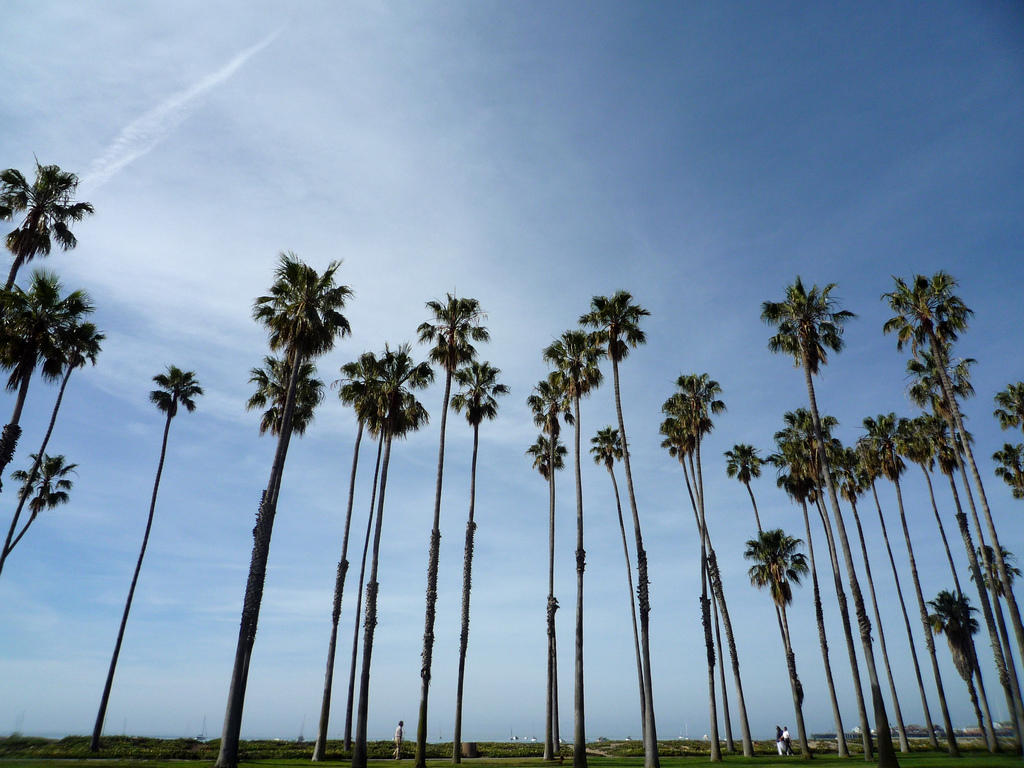
The resort-like city has been home to celebrities like Oprah Winfrey, Danny Elfman and Jeff Bridges. by Jeff Turner
Wine Tasting in the City of Santa Barbara
Santa Barbara is rightly named “America’s Riviera” as it gives visitors the ability to go from world class surf and coastline, chi-chi tasting rooms downtown, to the wine country itself… all within 30 minutes. You can do your own self-guided tour of the 26 urban tasting rooms after you sun, shop and dine downtown in the “funk zone,” located steps from the beach.

Travel Tip
Ignore your nav and drive highway 154 into wine country from the city. As you depart Santa Barbara and ascend the Santa Ynez mountains, you can watch the ocean and city disappear behind you while being engulfed in the breathtaking mountain pass. On the other side of the pass, you get a great bird’s eye view of Lake Cachuma framed by the massive San Rafael mountains in the background. Pull over at one of the turnouts and indulge in the truly spectacular scenery. This is a fun route for motorbikes.
Santa Barbara Wine Country
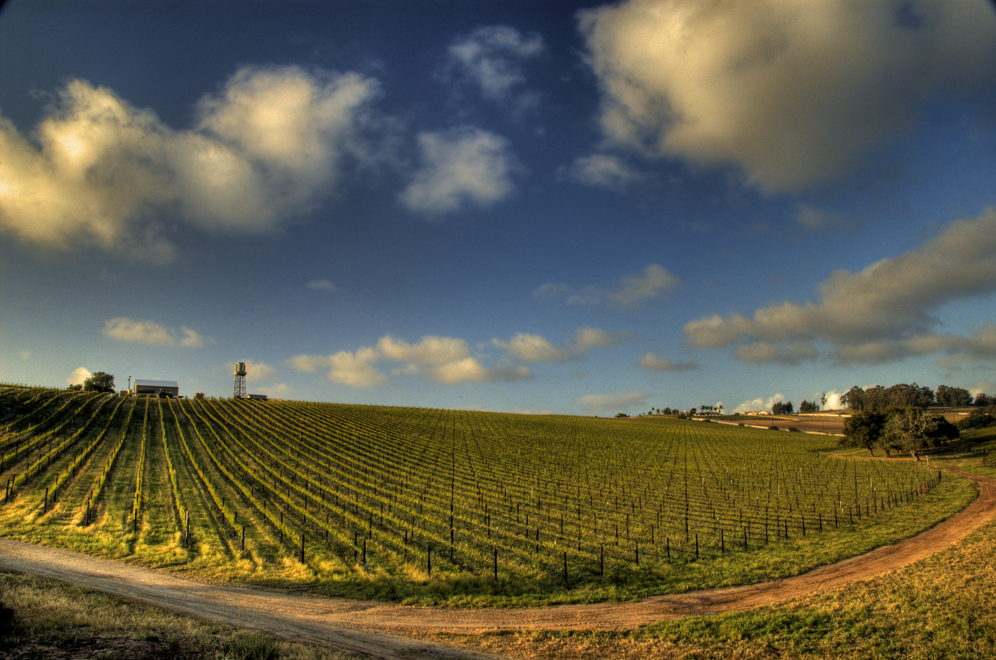
Vineyards outside of the city of Orcutt, just southwest of Santa Maria. photo by Daniel Hoherd
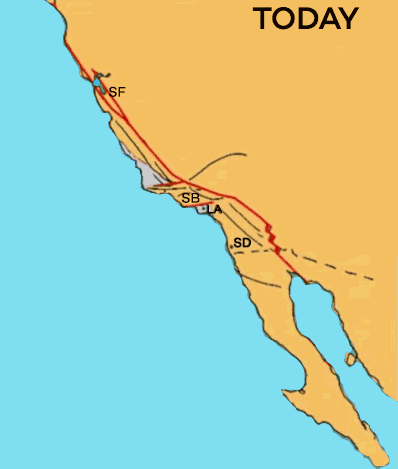 Santa Barbara wine country is sandwiched between two mountain ranges with elevations ranging from 200 feet in the valley to 3400 feet in the hillside vineyards. The transverse (ahem… East to West) nature of these mountain ranges is unique to the region and forms a collage of microclimates and soil types while keeping the region cool. Soils range from pockets of calcareous limestone that help maintain acidity, diatomaceous earth (aka DE) creates concentrated wines, sandy soils make more fruit driven styles, and finally, clay loam mixtures retain moisture for thirsty vines.
Santa Barbara wine country is sandwiched between two mountain ranges with elevations ranging from 200 feet in the valley to 3400 feet in the hillside vineyards. The transverse (ahem… East to West) nature of these mountain ranges is unique to the region and forms a collage of microclimates and soil types while keeping the region cool. Soils range from pockets of calcareous limestone that help maintain acidity, diatomaceous earth (aka DE) creates concentrated wines, sandy soils make more fruit driven styles, and finally, clay loam mixtures retain moisture for thirsty vines.
Read more about how soil types affect wine.
Through the “coriolis effect “,” the cool winds from the western opening to the Pacific Ocean act as a funnel pushing breezes and fog east through the valley. Only the warmest regions (Happy Canyon AVA) in the far northeast are spared from this chilling effect. This is why the region is famous for being one of the coolest grape growing regions in California, with average temperatures peaking around 70–80 °F (20–27 °C) and dropping to around 50 °F (10 °C) at night. The chill of the fog and breezes help extend the growing season–harvest can go through October,–allowing grapes to fully ripen without excessive sugar levels (lower sugar = lower alcohol levels). This is the key behind what makes these wines so elegant and unique.
The official wine regions (AVAs) of Santa Barbara
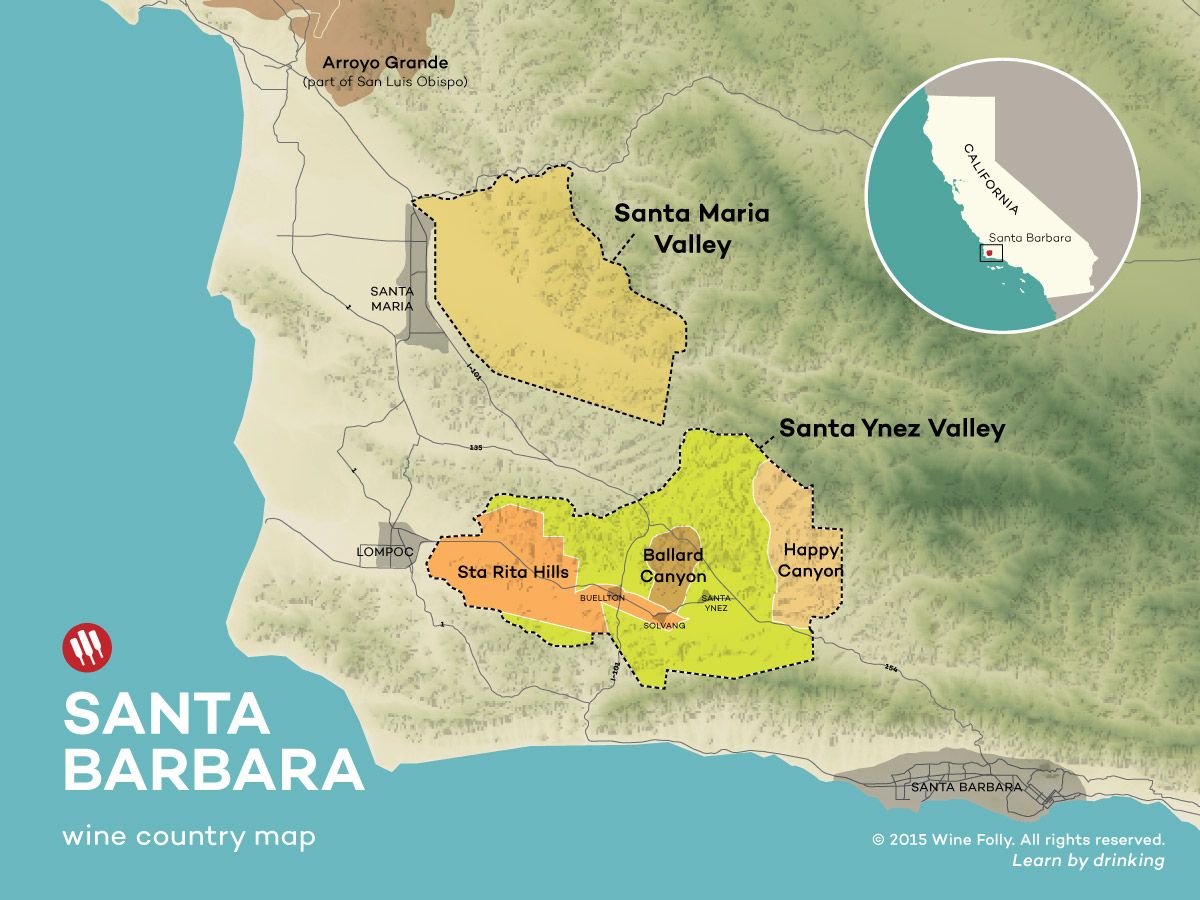
This map illustrates how the hills create the tranverse valley of Santa Barbara
Santa Maria Valley
This funnel shaped region is host to arguably the longest growing season in California (125 days) due to chill average temperatures around 64 °F. It is the regions first AVA, (established in 1981) and the first region that planted Chardonnay and Pinot Noir in Santa Barbara. Santa Maria contains Bien Nacido vineyard, a sought-after 900 acre vineyard for Chardonnay and Pinot Noir.
Look for Chardonnays with flavors of lemon zest, nectarines and pears and a firm backbone of acidity–built to age. Pinot Noirs are highly aromatic (violets, roses, spices) with an undertone of savory meat and a powerful structure. Syrah also seems to be at home here as well, bringing meaty, tobacco, and spice notes in a more Northern Rhône style than a Californian one.
Santa Ynez Valley
This is by far the largest AVA in the region, clocking in with 77,000 acres planted to over 60 different varieties and spanning over 30 miles east to west. Moving from west to east the climate goes from chilly and foggy (home to Pinot Noir, Chardonnay and Syrah) to warm and dry (good for Rhône blends, Zinfandels, and Bordeaux blends). Soils vary as well from well drained sandy soils on the valley floor to silty, clay, shale loam blends in the foothills. The region also has some rapport for Sauvignon Blanc from the historic Brander vineyard–it’s crisp and refreshing.

Travel Tip
Within Santa Ynez county are the unique townships of Solvang and Los Olivos. Solvang was founded by the Danish in 1911, reflected in the wind mills and half timbered buildings. There is an annual “Solvang Danish Days” complete with Viking reenactments and costumed gentry wondering the streets. Los Olivos, acclaimed for its “porch culture” where laid- back neighbors hang out and chat like the old days, was a Stagecoach town established in the 1860’s. Matteis Tavern originally housed passersby and is now a luxury hotel and dining destination.
photo by Michael
Sta Rita Hills
On the edge of ripeness, this small (2700 planted acres) hilly AVA lies in the western part of the larger Santa Ynez AVA. Famous for calcareous soils and a marine layer that sticks around till 10 am–this windy region is for Burgundy lovers. Dark fruited (plums, black cherries) and highly concentrated Pinot Noirs dominate representing 2000 acres, followed up by taut, racy Chardonnays (500 acres).
Ballard Canyon
Right smack in the middle of the greater Santa Ynez AVA lies this north-south oriented sub-AVA making a name for itself behind its mouthwatering Syrah. 50% of this region is devoted to this grape making it the only AVA in the USA devoted to this grape. Another 30% of plantings are to its fellow Rhône varieties like Grenache, Viognier and Roussanne. Because of its unique orientation, climate is the most mixed here. Huge diurnal shifts with daytime temperatures peaking 90 °F and nighttime getting down to 40 °F combined with fog in the south that burns off later than the higher elevations in the north, yields fully ripe blackberry and blueberry flavored Syrah with racy acidity levels and a silky texture. Syrah wines from here are noted for having more weight and concentration than a French Syrah (from Northern Rhône) but more vibrancy and freshness than warmer regions like Napa.
Happy Canyon
Lying on the far east border of the greater Santa Ynez AVA lies this hot and hilly AVA. Named during prohibition by folks who would “take a trip up Happy Canyon,” this region still makes cheerful wines. Unique to this region are the high magnesium content in the soils and hot daytime temperatures (peaking in the 90 °F). This results in low yields and fully ripe late ripening, magnesium demanding grapes like Cabernet Sauvignon, Petit Verdot and Cabernet Franc, as well as grapes that require a lot of heat like Syrah and Grenache. The resulting styles are highly concentrated with jammy black fruits and a long mineral driven finish.
The unofficial regions of Santa Barbara
In addition to the established AVA’s, there are 2 other regions making noteworthy wines in Santa Barbara that you should know about.
Lompoc
Affectionately called the “Wine Ghetto,” this odd-looking-but-joyous converted strip mall is home to the 2nd highest number of tasting rooms in the area (24, in fact). If you feel like a more urban experience, this group of passionate producers offers a down to earth experience of the wines they make mainly sourced from the Sta Rita Hills nearby.
Los Alamos Valley
Much like the town of Santa Ynez itself, Los Alamos offers the visitor a step back in history to a time when stagecoaches and railroads reigned supreme. The region itself is cooler than Santa Ynez, but warmer than Santa Maria valley, which means it has a wide diversity of wine varieties. Although the region is famous for its premium stone fruit driven Chardonnay, other favorites include Grenache-Syrah blends and Pinot Noir.
The Future of Santa Barbara?
Sideways put Santa Barbara on the map (or wait, was it the other way around?) showing the rest of the world the beauty and quality found in this cool climate growing region. Today, the region has continued to grow and evolve with the addition of places like Los Olivos and Los Alamos Valley working to become Santa Barbara’s newest sub-AVAs. There has also been a recent increase in plantings of unique varietals including Chenin Blanc, Trousseau Gris, Gruner Veltliner, Cabernet Franc and Gamay. Amy Christine, a Master of Wine and grower in Sta Rita Hills, tells us that this region is actively adding diversity to the region. If you ever wanted to check this area out in person, now is the time.
Sources
Amy Christine, MW and owner of Black Sheep Finds in Lompoc
sbcountywines.com for wine growing area info
Happy Canyon AVA https://happycanyonava.com/
Ballard Canyon AVA
Sta Rita Hills AVA
Los Alamos Valley
an article on the region from Napa Valley Register
Santa Maria Valley wine country
maps created by Madeline Puckette, Wine Folly.




